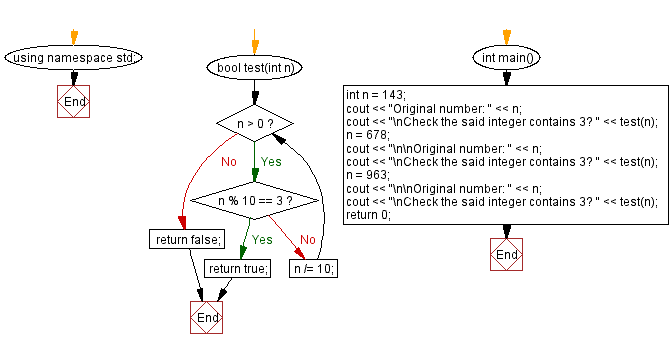C++ Exercises: Test a positive integer and return true if it contains the number 2
Check if Number Contains Digit '3'
Write a C++ program to check a positive integer and return true if it contains the number 3. Otherwise return false.
Test Data:
(143) -> 1
(678) -> 0
(963) -> 1
Sample Solution:
C++ Code :
#include <iostream> // Including input-output stream header file
using namespace std; // Using standard namespace
// Function to check if a given integer contains the digit 3
bool test(int n) {
while (n > 0) {
if (n % 10 == 3) // Checking if the last digit of 'n' is 3
return true; // Returning true if 'n' contains the digit 3
n /= 10; // Removing the last digit of 'n' by integer division
}
return false; // Returning false if 'n' does not contain the digit 3
}
// Main function
int main() {
int n = 143; // Initializing 'n' with an integer value
cout << "Original number: " << n; // Displaying the original number
cout << "\nCheck the said integer contains 3? " << test(n); // Checking if 'n' contains the digit 3
n = 678; // Changing the value of 'n' to a different integer
cout << "\n\nOriginal number: " << n; // Displaying the new original number
cout << "\nCheck the said integer contains 3? " << test(n); // Checking if 'n' contains the digit 3
n = 963; // Changing the value of 'n' to another integer
cout << "\n\nOriginal number: " << n; // Displaying the new original number
cout << "\nCheck the said integer contains 3? " << test(n); // Checking if 'n' contains the digit 3
return 0; // Returning 0 to indicate successful completion of the program
}
Sample Output:
Original number: 143 Check the said integer contains 3? 1 Original number: 678 Check the said integer contains 3? 0 Original number: 963 Check the said integer contains 3? 1
Flowchart:

For more Practice: Solve these Related Problems:
- Write a C++ program to check if a positive integer contains the digit '3' in its decimal representation and output a boolean result.
- Write a C++ program that reads an integer, converts it to a string, and searches for the character '3', returning true if found.
- Write a C++ program to analyze a number and return 1 if any digit equals 3, otherwise return 0.
- Write a C++ program that determines whether the digit '3' appears in an input number by iterating through its digits.
Go to:
PREV : Create Array with Strings of Given Length from String Array.
NEXT : Create Array of Odd Numbers with Specific Length.
C++ Code Editor:
Contribute your code and comments through Disqus.
What is the difficulty level of this exercise?
